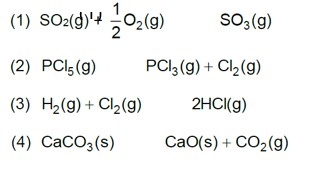7.15. At 700 K, equilibrium constant for the reaction:
H2?(g) + I2 (g) ?2HI (g)
is 54.8. If 0.5 mol L–1 of HI(g) is present at equilibrium at 700 K, what are the concentration of H2?(g) and I2(g) assuming that we initially started with HI(g) and allowed it to reach equilibrium at 700K?
7.15. At 700 K, equilibrium constant for the reaction:
H2?(g) + I2 (g) ?2HI (g)
is 54.8. If 0.5 mol L–1 of HI(g) is present at equilibrium at 700 K, what are the concentration of H2?(g) and I2(g) assuming that we initially started with HI(g) and allowed it to reach equilibrium at 700K?
-
1 Answer
-
H2 (g) + I2 (g)? 2HI (g); K=64, T=700K
2HI? H2 + I2 K=1/64700K
a 0 0
a (1−α) aα/2 aα/2
0.5 x x
x2 / (0.5)2 = 1 / 54.8
x2 = 0.25 / 54.8
x = = 0.068 M
At equilibrium, [H2] = [I2] = 0.068 M
Similar Questions for you
0.01 M NaOH,
M = 1 * 10-2

pOH = 2
pH = 2
Kp = Kc (RT)Dng
36 * 10–2 = Kc (0.0821 * 300)–1
Kc = 0.36 * 0.0821 * 300 = 8.86 » 9
A(g) ->B(g) + (g)
Initial moles n 0 0
Eqb. moles n(1 – a) na
total moles =
Eqb. pressure
On increasing pressure, equilibrium moves in that direction where number of gaseous moles decreases.
Taking an Exam? Selecting a College?
Get authentic answers from experts, students and alumni that you won't find anywhere else
Sign Up on ShikshaOn Shiksha, get access to
- 65k Colleges
- 1.2k Exams
- 679k Reviews
- 1800k Answers


